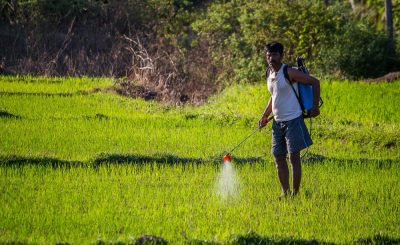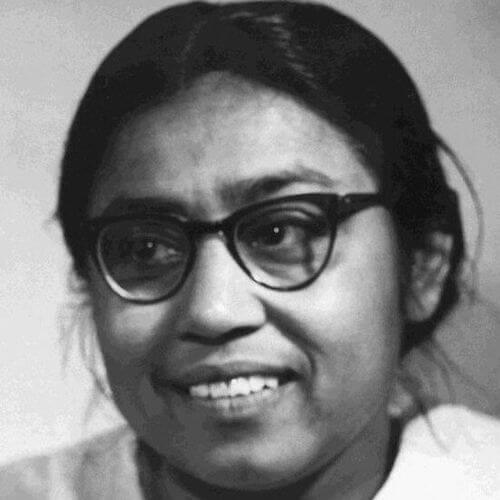India: Neglect of Land Reforms by the Country with the World’s Largest Rural Population Has High Costs

Harijanpur is a hamlet of about 140 households in Manikpur block of Chitrakut district (state of Uttar Pradesh). When some of the poorest people settled here about seven decades back, what helped them the most was a move initiated by the first woman Chief Minister in India Sucheta Kriplani to ensure that the poorest of the poor should also have some access to farmland. Even though this land was not considered very productive, it provided some essential base and food security to the people of this hamlet. Fortune smiled about two decades later when, making good use of the government’s Food for Work program, two voluntary organizations took up water conservation work. The irrigation from this tank has helped the people to meet their food needs in a reasonably assured way since then.
Image: Sucheta Kriplani (Source)

Gaya Prasad Gopal, an 85-year-old social activist who had played a crucial role in creating the tank in this village and at this age still insisted on accompanying me to this village on a hot afternoon, says—
“An extremely important lesson of my development experiences of about six decades has been that wherever we could secure some farmland for the rural poor, some secure base for food security could be created while those who remained landless also remained more vulnerable to hunger.”
There is increasing evidence that if properly used, even a small plot of just one or two acres of farmland can contribute a lot to the sustainable livelihood of a rural household. Bhuniya is a woman farmer of village Teraih (in Lalitpur district) who by combining multi-layer growth of vegetables, fruit trees and dairying with mixed organic farming of grain and legumes has created a highly creative and sustainable livelihood from a very small landholding of about 2 acres, an option not available to someone who is entirely landless.
This is a conclusion that is shared by several learned scholars and officials sympathetic to the cause of the rural poor, but unfortunately despite this the cause of land reforms has been increasingly neglected in recent times in India.
After independence from British rule in 1947, India’s land reforms efforts started with the aim of helping landless farm toilers to become small peasants owning small plots of farmland. Seventy years later we can see that achievements regarding this have been very small. On the reverse side, several factors have combined to turn many small and middle farmers into landless workers. This is due to massive displacement, land-grab, indebtedness, high costs, ecological ruin and other factors. What started as the noble aim of helping the landless farm workers to become farmers got reversed into the harsh reality of turning farmers into landless workers.
In the 2001 census, 127.3 million farmers were recorded while in 2011 census 118.7 million farmers were recorded, a reduction of 8.6 million farmers in one decade, at the rate of 2300 farmers per day or 100 per hour. Simultaneously there was an even bigger increase in landless farmer households, implying that farmers and some artisan households had been turned into landless workers.
Women farmers are even more vulnerable to land loss. Rukha, in Baraicha village of Banda district, was twice beaten by a big landowner who had his eyes on grabbing her small piece of farmland which was close to his sprawling house. It was only due to the intervention of activists that Rukha’s land could be saved.
Any comprehensive land reforms effort should include both these essential components – providing land to landless peasants and protecting land rights of existing farmers.
Such a land reform effort can be more useful than any other programme in reducing poverty, increasing productivity, ensuring food security as well as bringing peace and justice to Indian villages. What is more, such a programme can create the most enthusiastic mass base for a programme of ecological regeneration.
The Planning Commission of India had repeatedly expressed its agreement with this key role of land reforms. In the Tenth Plan document the commission stated, “the structure of land ownership is central to the well-being of the people.”
While acknowledging the crucial importance of land reforms, this official document also admitted the government’s growing reluctance (even opposition) to take up this important task,
“Land reforms seem to have been relegated to the background in the mid-1990s. More recently, initiatives of state governments have related to liberalising of land laws in order to promote large-scale corporate farming.”
The report of the Working Group on Land Relations for Formulation of the Eleventh Five Year Plan (the WGLREP Report) stated even more frankly,
“There is also immense pressure on the government to make available land to private parties either through land acquisition process or from its own pool of land meant for distribution to the landless and the small and marginal farmers. Land being a state subject, some state governments have already made changes in this direction in their legislations.”
Small farmers are likely to cultivate their fields more intensively and carefully, working hard to improve land fertility and productivity. Particularly in the context of sustainable farming practices and organic farming practices, it is the ability of farmers to carefully nurture and cultivate their fields, prepare organic manure and pest-repellents which is more important. This is clearly better achieved on small farms and family farms.
For somewhat similar reasons land reforms can also lead to a rise in farm productivity, that too on the farms of the poor. This view in supported by several international studies.
In a widely quoted publication titled ‘Agriculture Towards 2000’ the FAO has emphasised that more equal land distribution is likely to increase productivity of land,
“It is important to stress here that yields per hectare are as high on small as on large farms or, under traditional agriculture, even higher. With a few notable exceptions, total output per hectare is higher on small farms, chiefly because their intensity of land use is higher.”
The report by the FAO referred to above said in the specific context of India,
“Redistribution of only 5% of farmland in India, coupled with improved access to water, could reduce rural poverty levels by 30% under what they would be, so that in Indian conditions land and water reform would be a key approach.”
Making a comparison with the land reforms effort of other countries, S.R. Sankran a distinguished senior official who was Secretary of Rural Development, Govt. of India wrote,
“…the extent of land redistributed was 43 per cent of agricultural land in China, 37 per cent in Taiwan, 32 per cent in South Korea, and 33 per cent in Japan, whereas in India, the efforts of the central and state government to enact, revise and implement the ceiling laws, spread over 35 years, resulted in the redistribution of only 1.25 per cent of the operational area.”
Despite the tribal communities bearing the biggest share of the burden of many sided displacements and the high level of land-alienation, there was a flicker of new hope when during 2005-2008 the Scheduled Tribes and Traditional Forest Dwellers Forest Rights Act (briefly called Forest Rights Act or simply FRA) was passed and its rules framed. This Act hoped to correct the ‘historical injustice’ that had been caused to farmers.
But the real picture emerging from the implementation of FRA so far is very different. Firstly, the number of rejection of claims is very high. Those whose claim is rejected are often not even informed about it. Secondly, a significant number of deserving households have been simply left out as they could not send their claims properly on time. Lastly, even in the case of those whose claims were accepted, more often the acceptance is only for a small part of the land cultivated by them, hence even in acceptance cases the livelihood situation may be actually eroded. Hence the FRA, as presently implemented, may instead of correcting ‘historic injustice’ has the possibility of actually accentuating it.
Due to the denial of homestead land to hundreds of thousands of rural people, they have to live in very precarious and uncertain conditions. Sometimes the real or claimed ownership of the land on which they are living by big landowners ties the poor to a relation of bondage with them.
About homeless people of rural areas the WGLREP report says,
“In the vision of an emerging India, the right to a roof over one’s head needs to be seen as a basic human right, along with the right to freedom from hunger and a right to basic education.”
This report says,
“An estimated 13 to 18 million families in rural India today are reported to be landless of which about 8 million lack homes of their own. They live either in spaces provided by landlords (in case of farm labour), or park on government land, or on village common land, and so on. None of these options provide basic human security.”
It is in this wider context that the proposal for a law ensuring minimum land holding for all long-term resident rural households acquires many sided significance. Such a law could lay down, for instance, that all long-term residents of a village will have rights to homestead land and at least about an acre of cultivation land. However the size of the land holding can differ in hill and plain areas, and in irrigated and desert areas.
While land reforms with emphasis on some land for the landless need to be increasingly emphasized, India has been increasingly drifting towards an agribusiness led model which pays scant attention to the landless. Hence this is a particularly important juncture of India’s development journey for re-emphasizing land reforms.
*
Click the share button below to email/forward this article to your friends and colleagues. Follow us on Instagram and Twitter and subscribe to our Telegram Channel. Feel free to repost and share widely Global Research articles.
One Month Before Global Research’s Anniversary
Bharat Dogra is Honorary Convener, Campaign to Save Earth Now. His recent books include Man over Machine, Protecting Earth for Children and Planet in Peril. He is a regular contributor to Global Research.
Featured image is from Pixhive

